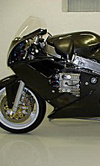When a pushrod fails
 Every part on a NHRA Full Throttle Drag Racing Series Top Fuel engine takes more abuse than in any other type of racing. It’s the nature of the beast. Even the pushrods can get hurt – although they might have the longest life span of any integral part in the valvetrain.
Every part on a NHRA Full Throttle Drag Racing Series Top Fuel engine takes more abuse than in any other type of racing. It’s the nature of the beast. Even the pushrods can get hurt – although they might have the longest life span of any integral part in the valvetrain.
This particular Manton intake pushrod was installed for eliminations at the penultimate NHRA round (of 24) on The Strip at Las Vegas Motor Speedway. It was being used in the Don Schumacher Racing Matco Tools Top Fuel rail of Antron Brown, who finished third in the season-long standings after leading the regular season point chase. Brown’s engine had a problem during eliminations that exposed the pushrod to a head gasket failure – or maybe a tune-up failure, according to co-tuner Rob Wendland.
The engine “dropped a hole [cylinder] and normally, in qualifying you would have gotten out of it,” said Wendland, “but in eliminations you can’t do that. It picked the hole back up and basically lifted the cylinder head. It was really ugly,” he told me.
Each intake and exhaust pushrod is thoroughly checked after every single pass down the 1000-foot dragstrip. “We look at the ball end; we look at the cup end and make sure there are no cracks to the cup or the ball,” Wendland said. “We have a fixture that we put the cup and ball ends into, then tighten it up a little to hold it perfectly centred. By twisting the pressure on the pushrod, if the indicator moves at all, like 8-9 thousandths out of round, we take it out of service – but that’s not usually the case.”
The Matco Tools team has moved its usage to a completely solid, billet pushrod that can last as many as 200 runs, Manton confirmed. The pushrod shown here is a solid tool steel intake pushrod and it is a bit thicker than 475 thousandths in diameter.
“We used to worry about a couple of things. Weight was an issue and moving up and down at 8500 rpm, a part that is heavier, it’s hard to move that pushrod up and down. You have masses going this way and masses going the opposite way. We learned that it’s not weight – the biggest issue is the correct opening and the correct opening speed that keeps the longevity of the part,” he said.
The cup configuration has stayed the same but the material for these pushrods has changed a little bit over the years. “The thinner part is billet tool steel and the other pieces are actually put onto this particular pushrod,” according to Wendland.
The pushrod tips are press fit into the centre section with a specific, very accurate pressure fitting. This manufacturing process allows a pushrod producer to use different materials for a more properly manufactured pushrod.
Manton is able to push both ends to this billet piece and make it stable. Or relatively stable within the realm of its punishing environment.
Words and photo by Anne Proffit.